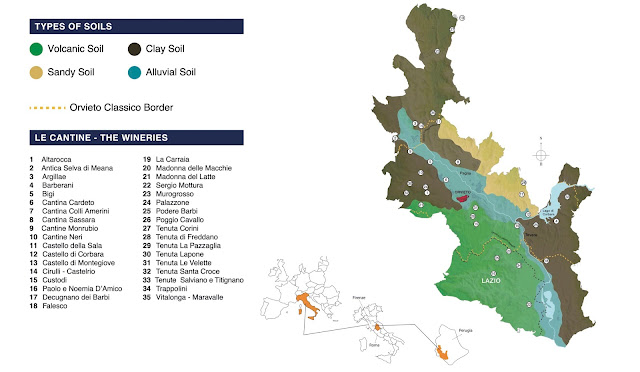The region of Umbria is often overlooked by its neighbor Tuscany. Located just north of Rome is one of the majestic medieval towns of Umbria, Orvieto. Set atop a hilltop made of volcanic tufo rock, this town was founded by the Etruscans. I traveled to Orvieto many years back and adored its quaintness. The quiet medieval side streets with a bustling center filled with unique shops from local craftsmen. Plus, the eye-catching Duomo alone is worth the visit in itself. Don’t forget to check out the hand carved underground caves by the Etruscans that were used to preserve wine and food along with the rock that was used to construct the buildings.
 |
| Sourced from Consorzio Vino Orvieto |
When it comes to wine what I find fascinating about Orvieto is that it contains about 80% of Umbria’s vineyards. In recent years from several tastings of Orvieto wines, I have come to really enjoy and appreciate the wines produced there. It has a unique microclimate created by the Paglia river that flows through the valley along with its proximity to two lakes, Lake Bolsena in the nearby Lazio region and Lake Corbara within Umbria. Lake Bolsena is in the eastern part of Lazio and is one of the oldest and biggest volcanic lakes in Europe and the largest volcanic lake in Italy.
The wines of Orvieto have long been appreciated by nobility of the Middle Ages. Orvieto is best known for its dry style wines, but there are also sweeter styles as well as late harvest wines. The typical dry wines are known to be floral, crisp and delicate with lively acidity, citrus and lingering salinity on the palate. The soils of this area are rich in the volcanic tufo rock and limestone with marine sediment that lend minerality to much of the wines.
 |
| Sourced from Consorzio Vino Orvieto |
Wines of the Orvieto DOC are made of 60% of Grechetto and Procanico. Procanico is a local name for the biotype of Trebbiano Toscano. If you remember last week we talked about the Trebbiano Spoletino grape and this is another type of Trebbiano. The remaining 40% can include Canaiolo Bianco, Verdello, Malvasia Biana and other white grapes that are allowed. The DOC encompasses both the Terni province of Umbria and the Viterbo province into Lazio, although a larger part of the production is in Umbria. It’s always worth seeking out those from the Classico zone, which is the historical center of wine production in Orvieto.
Have you visited the ancient town of Orvieto or drank these wines? I'd love to hear what you think.
No comments:
Post a Comment